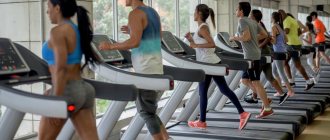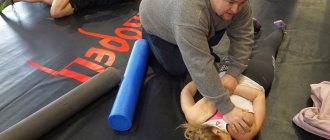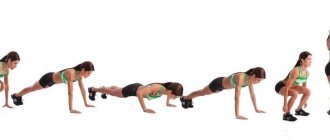If you are bored with monotonous running workouts, want to lose weight faster, feel athletic progress, and improve your performance, then pay attention to interval running.
Interval running is a type of running training that combines alternating fast and calm paces. Unlike fartlek, the intervals are fixed throughout the entire distance.
This type of exercise is very effective for different people: sprinters, long-distance runners, people who want to burn more calories. Interval running is used to prepare for a marathon and is part of the training of athletes of other disciplines.
Today we will discuss: what are its advantages, how to choose the right pace, calculate intervals and what to pay attention to?
How does interval running affect the body?
Running is an aerobic cardio exercise. The energy for this type of training is generated by the breakdown of glucose using oxygen.
Blood glucose is used first, then muscle + liver glycogen reserves. After this, fats come into play. Losing weight occurs without losing muscle mass!
The intensity of the load depends on:
- The rate of burning glycogen and then fat;
- The ability of muscles to more actively use oxygen + get rid of breakdown products;
- Adaptability of the cardiovascular and respiratory systems.
Interval running is an intense exercise that speeds up all these processes.
Scientists have found that after running for about 2 minutes at a fast pace, the body maintains the same high metabolic rate for another 5-7 minutes. This means you run fast for 2 minutes, and your body “works fast” for 7-9 minutes!
At the same time, the body does not get used to the monotonous load, which means it functions at maximum all the time, without saving energy.
Professional sprinters often have problems with bones, joints, and tendons. Interval running training adapts the body to high loads, reduces injuries, and spares the musculoskeletal system.
Literature
- Boyko A.F. Do you like running? – M.: Physical culture and sport, 1989. – 160 p.
- Volkov V.M., Milner E.G. Man and running: Medical and biological foundations of health-improving running. – M.: Physical culture and sport, 1987. – 145 p.
- Korobov A.N. Almost everything about running. – M.: Physical culture and sport, 1986. – 64 p.
- Korshunov A. M. Run towards the morning. – M.: Sov. Russia, 1984. – 144 p.
- Kots Ya. M. Sports physiology: Muscular apparatus and endurance. – M.: Physical culture and sport, 2014. – 30s.
- Kukalevsky G. M., Graevskaya N. D. Fundamentals of sports medicine: Textbook for physical education institutes. – M.: Medicine, 2011. – 368 p.
- Myakinchenko E. B. The concept of training local endurance in cyclic sports. – M.: Physical culture and sport, 2007. – 48 p.
- Polunin A.I. Theoretical and methodological foundations of managing the training process in long and ultra-long distance running when organizing independent training. – M., 2009. – 65 p.
- Seluyanov V.N. Preparation of a middle-distance runner. – M.: Sport Academ Press, 2011. – 104 p.
- Khomenkov L.S. Athletics Coach's Book. – M.: Physical culture and sport, 2012. – 399 p.
- Shedchenko A.K. Running for everyone: collection. – M.: Physical culture and sport, 1984. – 112 p.
Author: Korolev E.S.
Reviewer: reflexologist Kurus A.N.
Why do you need interval running?
The following characteristics are important to an athlete: speed + endurance. They are directly related to three indicators:
Download training plans to prepare for the marathon and half marathon.
Start preparing right now!
- MOC (maximum oxygen consumption);
- PANO (lactate threshold);
- Running economy.
The benefits of interval running for the development of these indicators are maximum.
Maximum oxygen consumption
MIC is the largest number of milliliters of oxygen that a person can consume in 1 minute (ml/kg/min).
Considering that running is an aerobic exercise, oxygen is very important! Each interval training “teaches” the body to absorb more oxygen, run faster, without going into the anaerobic zone.
Lactate threshold
PANO is the moment of transition from an aerobic method of energy production to an anaerobic one.
At this point, the accumulation of lactic acid in the muscles exceeds the rate of its elimination, and the pH of the muscle fibers decreases. Regular interval runs allow you to maintain a high pace longer, accumulating lactate more slowly.
Economical
Running economy shows your level of efficiency in consuming oxygen and burning calories.
To run a distance with the same VO2 max level, less energy will be required. Now it becomes clear why interval running for burning fat, increasing speed, endurance, and muscle strength is so effective.
Basic Rules
In order to quickly and permanently get rid of extra pounds by performing alternating physical activity, it is important to strictly follow a number of recommendations. Key rules for interval running:
- Regularity. You need to run at least three times a week, combining training days with your usual routine. It is better to do training at the same time.
- Duration. Each workout should last at least half an hour. This is due to the fact that the fat burning process starts only from the 15th minute of intense exercise.
- Warm up. It is an integral part of the lesson and is aimed at preparing the body for intense exercise. When carrying out this procedure, you should not save energy on heating.
- Maintaining water balance. The average daily drinking regimen should be about one and a half liters. You can safely drink water both before the start of the race and after its completion. The only exceptions are minutes of rest between intense sections of the distance. At this time, it is better to focus all your efforts on restoring breathing and heart rate.
- Control of food intake. Running on an empty stomach, as well as on a full stomach, is not recommended. 30-40 minutes before exercise, it is better to focus on foods rich in carbohydrates that have a low glycemic index in your diet. This decision is explained by the ability of carbohydrates to be quickly absorbed, giving the body a supply of glycogen, which is converted into energy.
To ensure that the results of interval running are not long in coming, in addition to well-distributed loads and a moderate diet, you need to add good sleep to your schedule.
Types of interval training
Interval running can be different, it all depends on the athlete’s preparedness and goal.
Types of interval training have one common principle - alternating fast + calm running with cyclic repetitions of sections. The duration of intervals and speed vary.
Basic Interval Training
If you're training for a competition, use the same (target) speed for your main interval training. In this case, the body adapts to this specific result.
The average length of the segments depends on the athlete’s level of training.
Fast Interval Training
The fast type interval running program involves a higher speed than in competitions. The duration of the segments is shorter than during basic interval training. Develops speed, MPC.
Long Interval Training
The intervals are longer than in the previous two cases, but the running pace is lower than the competition one. Develops endurance, increases the lactate threshold.
Contraindications
Interval training puts a lot of stress on the body. Therefore, they are not suitable for everyone. Contraindications to such activities are:
- heart diseases;
- high pressure;
- joint problems;
- large excess weight:
- low level of physical fitness.
Thus, only healthy people can do interval running. Beginners should put these activities aside and run regularly at a moderate pace for several months.
Features of the technology
Interval training has its own distinctive features. Running technique, number of intervals, length of segments, sum of cycles - everything matters. Let's break down interval running for beginners.
- The principle of interval training is to prevent the muscles from fully recovering from intense exercise and repeating it again. Therefore, a calm pace should not last longer than 5-6 minutes. This is the period of complete recovery;
- The number of approaches ranges from 3-12 times. 3-4 approaches - toning, 5-12 - training for progress, more than 12 - muscle destruction (catabolism);
- Intervals at a fast pace should be performed in a heart rate zone of about 85% of the maximum (maximum heart rate = 220 - age). This is about 167-172 beats/min for a 20 year old person;
- To improve speed characteristics, it is worth increasing the interval of a calm pace, shortening and making the interval of a fast pace more intense;
- To improve endurance, you need to reduce the rest interval + reduce speed;
- It is important to maintain the same pace throughout all acceleration intervals. If you run the first segment faster than the subsequent ones, the desired effect will not be achieved;
- Interval running for beginners should be included in the training plan no earlier than after 2 months of jogging;
- You should include interval training no more than 1-3 times a week, as this is a high-intensity load that requires a long recovery. The processes of accelerated metabolism that start in the body continue after jogging;
- It is very important to follow the running technique: back straight, arms at 90 degrees near the body, legs landing under the center of gravity in the middle of the foot. If the technique is incorrect, the legs begin to “jump” rather than run, the load is distributed incorrectly, and injuries are possible;
- Be sure to monitor your pulse. High-intensity running is performed at a heart rate of up to 85% of the maximum, and low-intensity running - 60-70%;
- Be sure to spend at least 15 minutes warming up + 10 minutes cooling down.
Who is it suitable for?
The key principle of jogging is to alternate between activity and calm modes. Although this approach is effective, beginners should not attempt it without prior preparation. If you switch to such activities earlier than six months of regular cardio exercises, you can provoke serious problems with the heart and blood vessels.
For those who are just starting to practice the “torn” technology, the standard lesson time should not exceed 30-40 minutes, of which only 20-25 are at the stage of grueling actions. You can increase the distances you run and the number of approaches only after a couple of months.
Interval training for weight loss
Interval running for weight loss is an excellent tool. Fats begin to be burned faster, the rate of their utilization is higher, and the workout itself can be shorter (30-40 minutes).
Weight loss occurs without loss of muscle mass. There is no effect of slowing down weight loss due to getting used to the load.
Scientists have proven that if you train correctly, you can lose 12.4% of fat in the first 1.5 months! Calories are burned 2-3 times faster than during regular running workouts.
Workout program for weight loss
For convenience, we have compiled several interval training programs for weight loss:
Program 1
- Warm up 15 minutes;
- 1 minute acceleration (pulse zone 165-175 beats/min) + 1 minute jogging (120-140 beats/min);
- 2 minutes acceleration (pulse zone 165-175 beats/min) + 2 minutes jogging (120-140 beats/min);
- 3 minutes acceleration (pulse zone 165-175 beats/min) + 3 minutes jogging (120-140 beats/min);
- 2 minutes acceleration (pulse zone 165-175 beats/min) + 2 minutes jogging (120-140 beats/min);
- 1 minute acceleration (pulse zone 165-175 beats/min) + 1 minute jogging (120-140 beats/min);
- Cool down for 10 minutes.
Include in your training plan 1-3 times a week.
Program 2
Suitable for those who have just started introducing interval running into their training program.
The “acceleration + calm pace” cycles are repeated 4-8 times.
| Week of training | Warm-up | Acceleration | Calm pace | Hitch |
| 1 Week | 15 minutes | 2 minutes | 4 minutes | 10 minutes |
| 2 week | 15 minutes | 3 minutes | 3 minutes | 10 minutes |
| 3 week | 15 minutes | 4 minutes | 2 minutes | 10 minutes |
Key principles
The start begins after a classic warm-up - running at a convenient and comfortable pace for about 10-15 minutes. Next, the alternation of intervals begins, which can be calculated using two methods:
- by duration;
- by distance.
The first one is suitable for those who are used to running with a watch and have no idea about the mileage of the route. The training organization algorithm is presented in the table below.
| Duration in minutes | Nature of the exercise |
| 15 | Warm-up |
| 1+1 | Acceleration, then rest |
| 2+2 | — |
| 3+3 | — |
| 2+2 | — |
| 1+1 | — |
| 5 | Restoring breathing, finishing the workout |
The algorithm for distance exercises is built in the same way, but the meters traveled are taken as the reference system.
Training programs
Another option for creating a training program is based on the distance of the segments.
Intervals 400-800 m
| Pace | Beginners | Experienced |
| Fast pace | 400 m | 800 m |
| Calm pace | 400 m | 600 m |
| The number of cycles | 4-5 | 6-8 |
Intervals 600-1000 m
| Pace | Beginners | Experienced |
| Fast pace | 1000 m | 1000 m |
| Calm pace | 800 m | 600 m |
| The number of cycles | 4-5 | 6-8 |
Useful tips
Running outdoors is much healthier than running indoors. Parks and forests are the best place for training. Their complicated terrain will increase the effectiveness of training, and the clean air floating around will saturate the body with oxygen, which is so necessary during intense exercise.
When training in a stadium with a marked track, it is convenient to measure intervals by distance. If training is carried out in a park or on the street, it is much more convenient to count intervals based on time.
Do you prefer to train in the gym? Use a treadmill for this. This solution is convenient because the equipment itself will control the intensity and duration of the intervals, as well as determine the number of calories burned.
Regardless of the location, you should not wear heavy sneakers or use weights when jogging. This will not significantly affect weight loss, but problems with joints may arise. During training, it is worth remembering that the exercises are based on alternating load intensity. Therefore, allocate enough time for slow sections, giving your body the opportunity to recover enough so that it can overcome the next section “without strain.”
It is important to monitor your pulse using a heart rate monitor for this purpose. In the absence of one, the number of strokes can be determined by placing your fingers on the carotid artery in the neck. To obtain the result, the number of beats in 15 seconds is multiplied by 4. The pulse rate will tell you when to increase or, conversely, reduce the intensity of the load:
- during the warm-up, the heart rate should be 60% of the maximum,
- when performing the main training complex - up to 80% of the maximum value.
If the rhythm of heart contractions reaches 90% or higher, you should begin to gradually reduce the load so as not to harm yourself.
Overall, interval running is the best way to get rid of cellulite and balance your weight. But this can only be achieved by showing persistence and demonstrating discipline.
Cruising intervals
This term was proposed by the famous American trainer Jack Daniels to refer to one of the types of threshold training, the main goal of which is to improve the ability to restrain the growth of lactate in the blood, that is, to increase PANO.
Intensity: For most runners, this is their 10K race pace. You can also determine the required pace using our VDOT calculator.
Duration: 800-3000m (or 3-10 minutes), but sections of 1600m are most often used.
Rest period: 30-60s depending on the duration of the interval.
Features: Be sure to stick to the chosen pace, otherwise your blood lactate will rise too quickly and you will not be able to complete the planned number of repetitions.
Examples of training: 3x800m (recovery 30-60s), 4x1200m (recovery 60s), 4x1600m (recovery 60s).
Read more about cruising intervals in the article What are cruising intervals and how are they useful for a long-distance runner?
MPC intervals
A scientific review2 examining the optimal intensity for increasing VO2 shows that high-intensity training (performed at 95-100% of VO2) is most effective for improving this indicator. This theory is supported by many famous trainers, including Jack Daniels and Pete Fitzinger. The main idea of such training is to accelerate your metabolism to a level close to your MOC and work at it for a long enough time, which will ultimately improve the aerobic capabilities of the body.
Intensity: Matches your current 3-5K race pace. You can also determine the required pace using our VDOT calculator.
Duration: Each interval is no more than 5 minutes or 600-1600m.
Rest period: equal to or slightly less than the time spent on the previous segment or from 50 to 90% of the time spent to run the interval.
Features: you must strictly adhere to the chosen pace, otherwise you will not be able to achieve the desired training effect.
Examples of training: 600m - 7-10 times, 800m - 6-10 times, 1000m - 5-8 times, 1200m - 4-5 times, 1600m - 3-5 times.











